What does it mean to achieve exponential growth as a direct-to-consumer company? With the constantly rising cost of acquisition (CAC) and an ever-changing landscape for paid media, it’s becoming increasingly difficult for brands to grow rapidly. Companies often think they can throw a few dollars into their Google Ads or Facebook account and then watch their sales skyrocket. While this may have been true a few years ago, it is no longer true. Proven growth tactics like the Peloton Marketing Strategy highlight the importance of staying informed about the latest marketing trends.
New and interesting tactics are becoming increasingly important to retain and engage potential customers, and that’s exactly how Peloton went from launch to a $3.9 billion valuation in less than 10 years and now boasts over half a million users. The Peloton Marketing Strategy puts community and content first, selling much more than just a bike. “Peloton sells happiness,” says co-founder and CEO John Foley.
And merriness sells at a luxury price point.
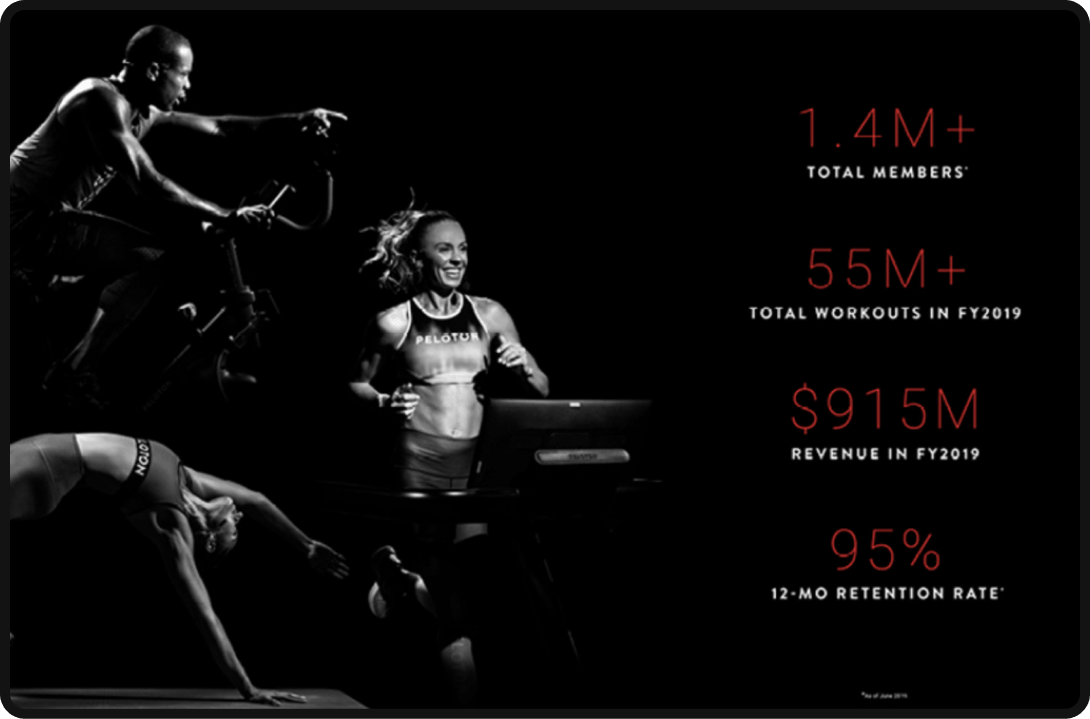
Peloton Marketing Strategy: Be Quick To Adapt
Focusing on the paradigm shift as the worlds of branding and performance marketing overlap, the Peloton Marketing Strategy understood how to ignite emotional responses among its user base. While FlyWheel and SoulCycle were busy luring customers to $34 classes at location-specific studios, Peloton saw the potential of the boutique fitness trend in New York and developed a new model. With the in-home bike, subscribers can achieve their fitness goals and become members of an engaged community without going anywhere. And their bikes are never soaked in other people’s sweat.
Hardware-plus-subscription business models have delivered some spectacular failures in recent years, Juicero being a prime example. So why has Peloton been successful? After a failed Kickstarter campaign caused them to rethink their actual offering, they quickly adapted to launch an entirely new category. The Peloton Marketing Strategy prioritized leveraging personalization, content, product development, and exceptional service to achieve an almost unheard-of 95% retention rate, which they call Connected Fitness Subscribers, while maintaining a monthly churn rate of 0.65%. To put that number in perspective: Netflix, a company we all know and love, has a retention rate of 93%, while Blue Apron, which showed early promise, now has a rate of just 13%.
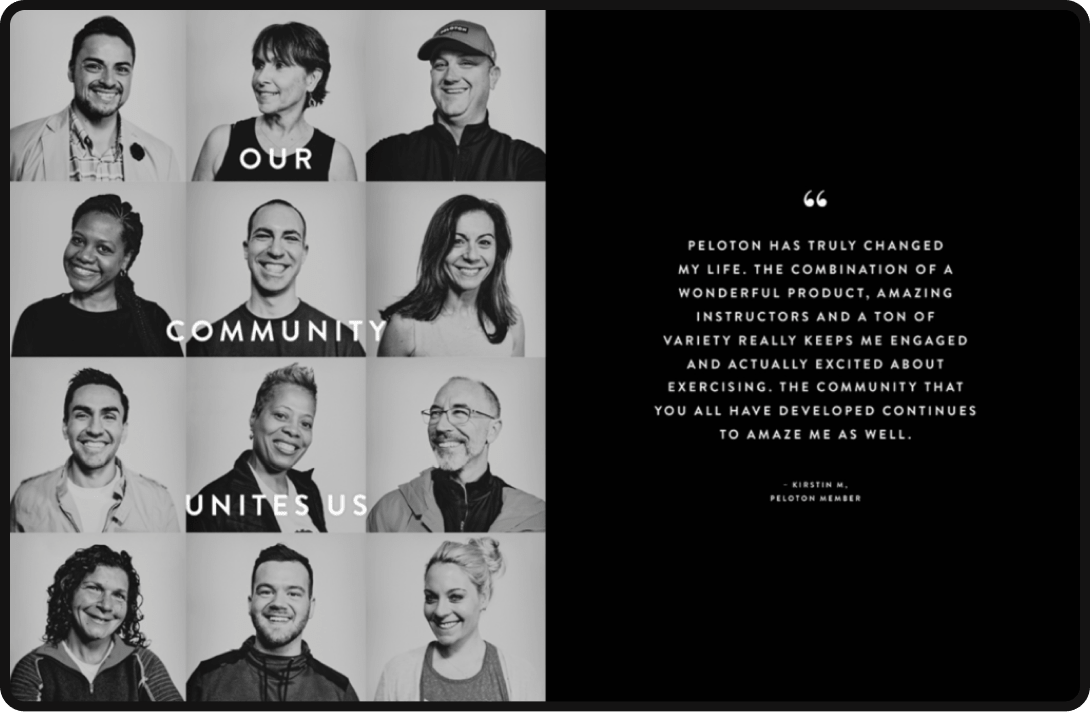
Boost Retention With Community
At-home cycling has been around forever (since 1796, to be exact), but Peloton has turned an activity you normally do in solitude into a community experience. Joining the community feels like a ritual. Users are asked to enter their complete bio: height, weight, gender, age, etc., and are invited to create a unique screen name (Hugh Jackman accidentally revealed his on Instagram recently).
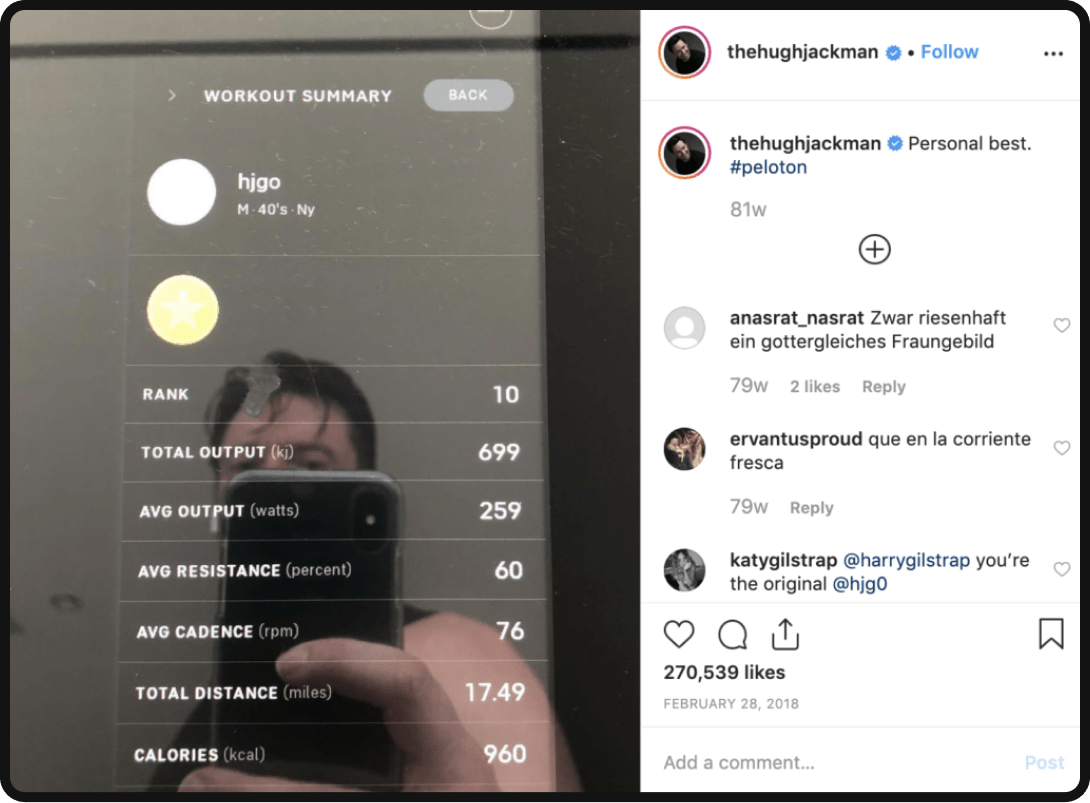
During classes, instructors use the data to give riders “shoutouts” for milestone rides and birthdays during live classes triggering an emotional, rewarding response. The bikes track the riders’ performance and remember their preferences.
Peloton encourages engagement as users are invited to race against each other and track their progress live. There’s nothing more motivating than realizing you’re lagging behind 200 of your closest friends and neighbors. The ability to send high-fives is another example of the Peloton Marketing Strategy aiming to meet users’ expectations and surprise and delight them. By gamifying the exercise experience, Peloton has tapped into what keeps its users returning for more.
If playing the Peloton game isn’t for you, you can opt-out. Turn off the leaderboard, and it’s just you and the instructor. The Peloton Marketing Strategy understands the ability to choose is as important as the feature itself. Celebrities are fans in part because they can get a quality workout without the selfie requests they would get at a regular gym.
The more personal the service is, the more involved users get entrenched in the community, and the more involved they feel, the more they use the service. As we know, Peloton stands behind the statement that “increased usage equals increased loyalty,” backing the customer stickiness of the Peloton Marketing Strategy.
Peloton listens to its user base. After completing a workout, members are asked for an immediate review of the workout, and targeted recommendations are made to encourage the user to try additional classes. For example, after a 30-minute ride, recommendations are made for classes outside of cycling, such as yoga and meditation. The product feedback and interaction loops allow Peloton to make changes quickly and adapt to user suggestions in real-time while keeping users engaged.
The loyalty created by the service is evident in the way the brand is discovered online. According to data from Similarweb, 55.71% of traffic is direct, while 38.36% comes from search. Even more impressive is that 91.01% of that search traffic is organic. The tribe of raving fans shares the brand with friends, and word-of-mouth referral is one of the most lucrative ways the Peloton Marketing Strategy drives new users.
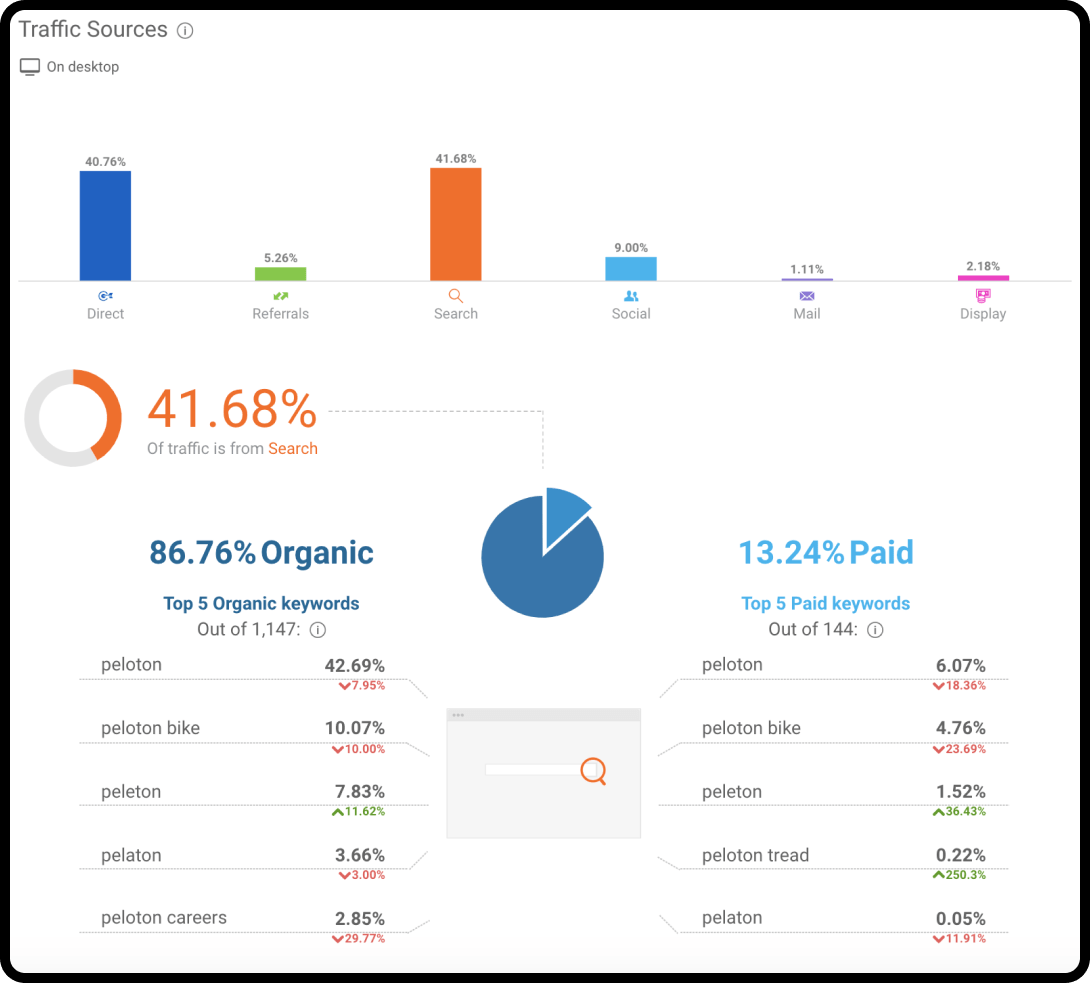
Content: But Keep It Legal
While Peloton is not without its faults, a group of music publishers sued Peloton in 2019, alleging it used more than 1,000 songs from Lady Gaga, Drake, Gwen Stefani, Justin Timberlake, and others without permission — content is at the heart of what has driven Peloton to such success. The most successful companies know to leverage content in many different formants.
With celebrity instructors (some of whom make more than 6 figures and have their own cult following) leading at least 12 new live classes daily, Peloton is a content machine. Some of their notable instructors are favorites like Cody Rigsby (683K followers) and Ally Love (641K followers). They also acquired Neurotic Media in 2018, a B2B music aggregation and streaming service, giving them a new edge in content generation.
“We’re trying to be creative with new forms of media that fall somewhere between earned media and more traditional marketing,” Foley said.

The Peloton Marketing Strategy includes a film studio, which pumps out about 950 original programs a month, is no joke. It may have started with 4 bikes in the back room of their office with rented lights, but it certainly isn’t anymore. The New York-based studio is staffed with top producers, some of whom have won Emmys for production excellence, and is a state-of-the-art film studio.
Content is so critical to Peloton that their website title and meta-description don’t mention the equipment. Instead, they highlight what Peloton considers the most valuable part of their business: the service.
Delivering Exceptional Product Experience
Product development at Peloton hasn’t stopped at a sexy spin bike design and celebrity-led classes.
They have been able to achieve tremendous growth in their subscription revenue by accepting that, for some riders, expensive gear just wasn’t an option. To serve this additional market, Peloton began selling digital memberships (no equipment purchase required) in 2018. The cost is just $39.00/month, and now, in 2024, there are about 2.33 million digital-only subscribers, with an annual retention rate of over 92%.
Peloton is constantly pushing for the latest and greatest, which keeps users signing up and staying. Looking for a workout away from the bike, like yoga, stretching, or even sleep meditation? There’s that, too, via the app. Prefer to run instead of riding a bike? Their newest product, Tread, is a treadmill that offers the same in-home workout experience as the bike.
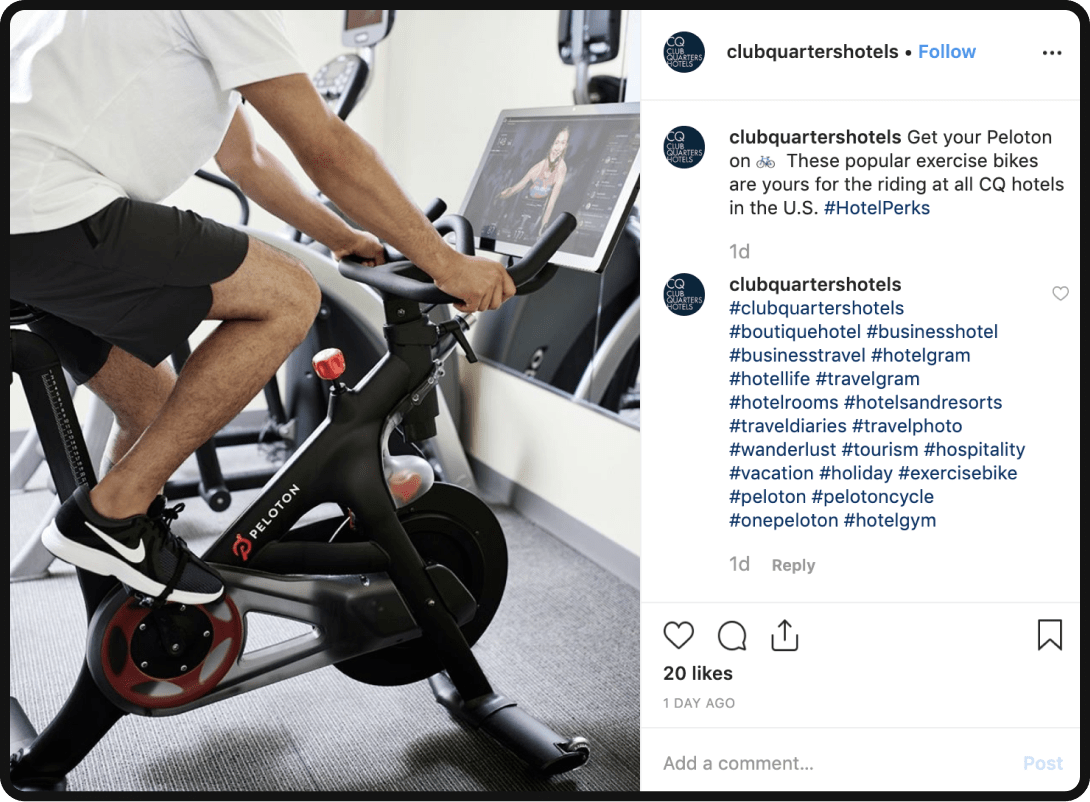
And it’s not just equipment and app innovation that has kept them at the forefront. The Peloton Marketing Strategy continues to evolve. Traveling? Stay at one of the more than 300 hotels offering private Peloton rooms where you get your own private bike and access to their network of classes. Waiting for a sale? Don’t hold your breath. Peloton rarely has sales and leans heavily on its referral program as the main source of discounts.
Other media investments include Facebook ads, retargeting, search engine marketing, email marketing, TV, and print. The company spent over $100 million on paid media in the last year, advertising on over 250 different media properties across multiple media formats.
Ready to meet your audience where they are?
Peloton’s pricing strategy has also had marketers talking. Peloton partnered with Affirm to offer frictionless product financing, enabling customers to pay off equipment purchases for as little as $50 per month over time. By eliminating this upfront cost, Peloton was able to remove many consumers’ hesitation and bring the price below that of a boutique fitness club membership, significantly strengthening their core value proposition (especially because multiple people can use the bike for the same subscription price). This financing also “locks in” users for 3+ years, which adds to the case for their low churn and high retention rate.
Peloton SVP of Global Marketing Carolyn Tisch Blodgett says, “While it’s nice to see headlines that say ‘the Peloton of rowing’ or the Peloton of something else, we’re not really focused on what our competitors are doing. We’re focused on solving needs for our core consumer through innovation.”
1.4 Million Users Who Expect the Best
Users are willing to pay a premium for exceptional service — and when the price point is high, so are their expectations. With members exceeding 1.4 million in 2019, the pressure is on the Peloton Marketing Strategy to continue to provide exceptional service. From the white-glove delivery to the consistent evolution of classes offered, this is a prime example of a data-driven approach allowing a company to leverage customer insights to provide best-in-class service.
Blodgett said, “Traditional fitness classes are 45 minutes, but our 30-minute classes outperformed, so we produced more. Many people like on-demand classes, so we’ve added features that make the on-demand classes feel like a live class.” Peloton uses customer data like demographics, location, etc., to target new users and drive acquisition, determining that their fastest-growing market is users under 35 with a household income of under $75,000.
As mentioned in their registration documents, “We use performance data to understand our Members’ workout habits to evolve and optimize our programming around class type, length, music, and other considerations.”
By going above and beyond to delight members, they have seen nothing but growth in year-over-year subscriber rates. When you make something exciting and worthwhile, people want to be part of it.
Peloton Marketing Strategy: Addictive Fitness
Achieving optimal user retention means creating a product that feels like a need more than a want. The Peloton Marketing strategy does just that. The $39/month Peloton subscription is mandatory when you buy the equipment and gives users access to the community and thousands of live and on-demand classes while generating consistent revenue and data for the company to use to improve its offerings. We’ve seen other subscription companies try to do what Peloton has done, but most with average success. The goal is to make the at-home fitness experience “as physically rewarding and addictive as attending a live, in-studio class,” according to the registration filing.
The keyword here is addictive. With retention rates through the roof, it seems it might be. On average, its subscribers complete 19.9 workouts per month, and subscriber engagement with Peloton workouts has grown 2.65x over the last four fiscal years (June 2017 – June 2021). And they do it all with very little churn. As they mention in the S-1, “Usage drives value and loyalty.” Peloton’s customer reviews average 4.8 out of five across more than 1,000 reviewers, according to Wirecutter.

Peloton Marketing Strategy: What’s Next?
“Arguably, the Peloton bike has been the most disruptive product in the fitness industry,” says William Lynch, the company’s president. “But that’s a really narrow view of what we’re doing.”
The impact Peloton has had on the fitness industry is huge, and there’s no doubt that it would be hard to return to the way things were before. With Peloton’s constant thirst for innovation, there seems to be no reason that Peloton won’t continue to thrive and push the boundaries of what consumers can expect from a hardware-plus-subscription business.
Countless competitors and imitators have popped up in recent years, including Mirror, an at-home device that touts itself as “the nearly invisible interactive home gym,” which was recently acquired by Lululemon, and SoulCycle or FlyWheel, which have now launched their own connected home bikes. Startups like Tonal have taken a different approach, focusing more on full-body workout functionality, incorporating magnetically powered weights for added resistance. Strava and Whoop, on the other hand, have established themselves as a way for athletes to track and measure their progress (and split times) with people in the real world.
Partner with us for cutting-edge growth marketing services that propel businesses forward.
What’s the takeaway here? The Peloton Marketing Strategy and the companies unwavering commitment to building community, creating a tribe of avid fans, generating quality content, and providing exceptional service, is a backed-by-science recipe to turn a failed Kickstarter into billionaire-dollar company.
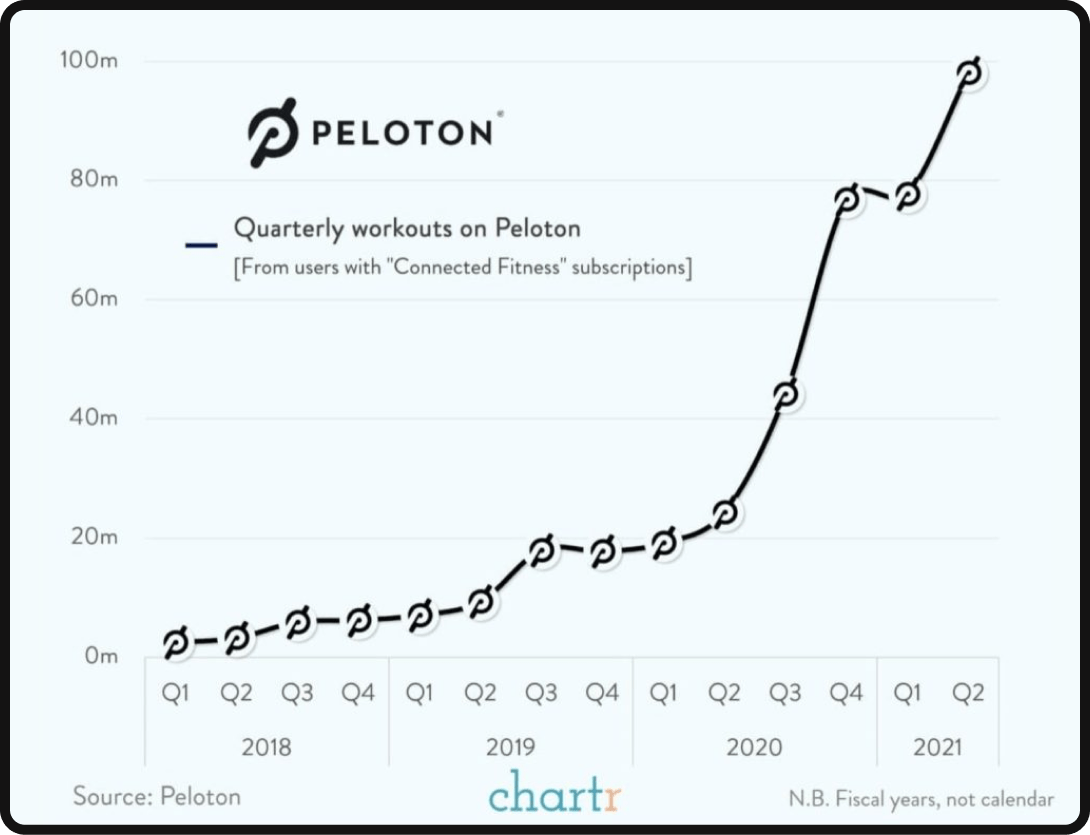
Understanding Peloton’s Breakout Year
Unlike many retail businesses, the Peloton Marketing Strategy benefited from the pandemic, becoming a top choice for home workouts as people were forced to move indoors and rethink their exercise routine. The demand for Peloton equipment has become so high that the company is struggling to keep up, prompting Peloton to raise its sales outlook for the full year. The company said heightened demand for its bikes has continued to grow as those who were not considering buying one before the Covid-19 crisis began to warm towards the idea.

Peloton Marketing Strategy: Power Of Influencer Marketing
As themed workouts became popular within the Peloton community, the company partnered with celebrity influencers. On November 10, 2020, Peloton announced its multi-year partnership with Beyonce Knowles to produce some of these themed workouts for their members. The announcement saw immediate success, with Peloton’s stock soaring 8.6% on the day of the announcement.
Customers were equally excited, with one follower on Peloton’s Instagram commenting, “This is so powerful. My personal trainer […] is a Howard student and he taught me how to use Peloton. This campaign makes me feel seen and valued as a current Howard student and Peloton user. Thank you.” Another wrote, “You market to ME, you get me! Peloton purchased.”
The Peloton Marketing Strategy and Beyonce collaboration was a win on all fronts. According to Peloton, Beyonce was the most requested artist among its 3.6 million members worldwide. That’s not surprising, given that millions already have Beyonce’s music on their workout playlists, but it’s not just her music that makes this partnership perfect. Beyonce is a global superstar, businesswoman, and activist with a massive fanbase (172 million followers on Instagram at the time of this article update).
Beyonce is a master of social media who truly understands how to connect with her fans, ignite conversations about everything, and sell (take a look at her first Ivy Park collection with Adidas, which sold out in one weekend). According to social media analytics firm D’Marie Analytics, one post from Beyonce is worth over $1 million in advertising.
Furthermore, the logic behind this partnership goes one step further: Beyonce is a performer known for her fitness and stamina, who often talks about the importance of prioritizing her health to achieve her goals and be the best version of herself. She embodies hard work and excellence — everything Peloton and its followers strive to be.
By partnering with Beyonce, a Black female artist, and building relationships with HBCUs, Peloton is taking steps to make the health and wellness industry more inclusive. Consumers in 2024 are becoming more aware and have higher expectations for companies to be inclusive and mindful in their business practices. By building partnerships like this, Peloton is sure to attract new subscribers who may not have previously seen Peloton as something they could use before.
The partnership has been a huge success and in a single quarter, 1 million people completed workouts featuring music by Beyoncé.
Peloton Launches DFB Partnership
Peloton’s path to further advance their role in fitness innovation includes the companies recent partnership with DFB Academy (German Football Academy). Through this partnership, the Peloton community can “train with” and and compete in “DFP” branded workouts. Not only did Peloton give its users another tangible benefit of being a member of the community, this marketing move positioned Peloton in front of a brand new segment of consumers. With its business partnerships and sales trajectory, there’s no doubt the Peloton Marketing Strategy is one to watch despite the tough competition in the space and we can’t wait to see what they dream up next.







This is really an in-depth article on Peloton’s rise. Really helpful!
Great read! I completely agree with the importance of creating a strong brand identity and leveraging customer testimonials in Peloton’s marketing strategy. Their focus on creating an immersive experience for their customers has been a key factor in their rapid growth. The use of social media influencers and partnerships with popular brands has also been a smart move to reach a wider audience. Looking forward to seeing how they continue to innovate and push the boundaries of their marketing strategy.